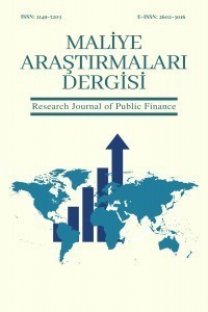Kamu Borç Yönetiminin Maliye ve Para Politikası ile Uyum Sorunu: Türkiye Pratiği
1929 Büyük Buhranına ilaç niteliğinde değerlendirilen Keynesyen politikalar, kriz döneminde başarılı sonuçlar vermesine karşın, kriz sonrası izlenen savurgan politikalar neticesinde bütçe açıklarına ve dolayısıyla artan kamu borç stokuna sebep olmuştur. Maliye politikasının artan borç stokunun ekonomi üzerindeki etkilerini yönetmede yetersiz kalması, önceleri maliye politikasının bir aracı olarak görülen Kamu Borç Yönetiminin, ayrı-bağımsız bir politika olarak devreye girmesini kaçınılmaz kılmıştır. Günümüzde kamu borcunun sürdürülebilirliği ve etkin bir kamu borç yönetimi politikası ile ekonomik istikrar arasında önemli bir ilişki olduğu kabul edilmektedir. Bu sebeple kamu borç yönetiminin bağımsız bir politika olarak kabul edilmesi ve makroekonomik çerçeve içerisinde para ve maliye politikaları ile uyumunun sağlanması büyük önem arz etmektedir. Bu çalışmasında kamu borç yönetimi, kamu borç yönetiminin para ve maliye politikaları ile uyumu, bu uyumun önemi ve Türkiye'deki gelişmeler incelenmiştir. Bu bağlamda kamu borç yönetimi, kamu borç yönetiminin para ve maliye politikaları ile karşılıklı ilişkileri, kamu borç yönetimi politikasının makroekonomik politikalarla uyumunun sağlanması sırasında karşılaşılan sorunlar ve bu sorunların etkileri ele alınmıştır.
Anahtar Kelimeler:
Borçlanma, Borç Stoku, Kamu Borç Yönetimi, Maliye Politikası, Para Politikası, Politikalar Arası Uyum.
Public Debt Management with Fiscal and Monetary Policy Appropriate Problem: Turkey Practice
The Keynesian policies, which were evaluated as medicines for the Great Depression of 1929, caused successful outcomes in the crisis period but resulted in budget deficits as a result of the extravagant policies followed by the crisis and thus the increased public debt stock. The inadequacy of fiscal policy to manage the effects of increasing debt stock on the economy has inevitably led to the Public Debt Administration, which was regarded as a means of fiscal policy, to take over as a separate, independent policy. It is accepted today that there is an important relationship between the sustainability of the public debtor and an effective public debt management policy and economic stability. For this reason, it is of great importance that public debt management is accepted as an independent policy and that it is compatible with monetary and fiscal policies within the macroeconomic framework. In this study, public debt management, compliance with the monetary and fiscal policies of public debt management, the importance of this harmonization and the developments in Turkey have been examined. In this context, public debt management, the interrelation of public debt management with monetary and fiscal policies, the problems encountered in ensuring compliance of public debt management policy with macroeconomic policies and the effects of these problems are discussed.
Keywords:
Borrowing, Public Debt Management, Fiscal Policy, Monetary Policy, Compliance Between Politics,
___
- ALEXANDER, William E., TOMAS J. T. Balino ve CHARLES Enoch. “Adopting Indırect Instruments of Monetary Policy”, Finance & Development. Vol. 33, No. 1, Mart 1996
- ANDERSON, Philip (2006), “Government Debt Management and Financial Stability: Background Notes”, Guidelines For Public Debtmanagement: Accompanying Document
- BAHAR, Habibullah (2009), “Interrelationship Among Monetary, Fiscal, Exchange Rate and Debt Management Policies”, Regional High-Level Workshop On “Strengthening The Response to The Global Financial Crisis in Asia-Pacific: The Role of Monetary, Fiscal and External Debt Policies”
- BLİNDER, Alen S. (1982), “Issues in The Coordination Of Monetary And Fiscal Policy”, Nber Working Paper No:982.
- CURRİE, Elizabeth, DETHİER, Jean-Jacques ve TOGO, Eriko (2003) “Institutional Arrangements for Public Debt Management”, World Bank Policy Research Working Paper No. 3021. Nisan 2003
- FELDSTEİN, Martin ve STOCK, James H. (1994), “The Use of A Monetary Aggregate to Target Nominal GDP”, Monetary Policy. N. Gregory Mankiw (Drl.), Chicago: The University Of Chicago Press
- HALAÇ, Umut (2007), ”Türkiye’de Para ve Maliye Politikalarının Koordinasyonu” İşletme ve Finans Dergisi. Cilt: 22, Sayı: 254
- HANİF, M. Nadeem. ve ARBY, M. Farooq. (2003), “Monetary and Fiscal Policy Coordination”, Munich Personal Repec Archive, 2003 Paper No:10307.
- Kamu Finansmanı ve Borç Yönetiminin Düzenlenmesi Hakkında Kanun (2002), T.C. Resmi Gazete, 4749, 9 Nisan 2002
- IMF (1998), “Coordination of Monetary and Fiscal Policies”, IMF Working Paper Wp/98/25.
- IMF (2003), “Guidelines for Public Debt Management”
- LAURENS, Bernard ve DE LA PIEDRA, Enrique G. (1998), “Coordination of Monetary and Fiscal Policies”, IMF Working Paper 98/25
- LEONG, Donna (1999), “Debt Management – Theory and Practice”
- İSMAYILOV, Hakim (2012), “Kamu Borç Yönetiminin Para ve Maliye Politikaları İle Koordinasyonunun Sağlanması: Türkiye Örneği”, İstanbul
- PİGA, Gustavo (2001), “Derivatives and Public Debt Management”, New York: Council Of Foreign Relations and Isma Center
- POPA, Ionela ve CODREANU, Diana (2010), “Fiscal Policy and Its Role in Ensuring Economic Stability”, MPRA Paper No. 20820
- SARGENT, Thomas J. ve WALLACE, Neil (1981), “Some Unpleasant Monetarist Arithmetic”, Federal Reserve Bank Of Minneapolis Quarterly Review, 5
- STORKEY, Ian (2001), “Sovereign Debt Management: A Risk Management Focus”, The Finance and Treasury Professional, Mayıs 2001
- THE WORLD BANK (2007), “Managing Public Debt: From Diagnostics to Reform Implementation”, World Bank, Washington DC
- TOGO, Eriko (2007), “Coordinating Public Debt Management with Fiscal and Monetary Policies: An Analytical Framework”, World Bank Policy Research Working Paper No. 4369
- WHEELER, Graeme (2004), “Sound Practice in Government Debt Management”, Washington DC: World Bank
- ISSN: 2149-5203
- Yayın Aralığı: Yılda 2 Sayı
- Başlangıç: 2015
- Yayıncı: PESA
Sayıdaki Diğer Makaleler
Küresel Finansal Krizin BRIC Ülkeleri Üzerindeki Makro Ekonomik Etkileri
Kamu Borç Yönetiminin Maliye ve Para Politikası ile Uyum Sorunu: Türkiye Pratiği
Mehmet Hanefi TOPAL, Hamdi Furkan GÜNAY
Rasyonaliteden İrrasyonaliteye: Davranışsal İktisat Yaklaşımı ve Bilişsel Önyargılar
Impact of Public Expenditures and Economic Classification on Growth: Turkey Analysis
Türkiye’de Savunma Eğitim ve Sağlık Harcamaları Arasındaki İlişki Hakkında Ampirik Bir İnceleme
